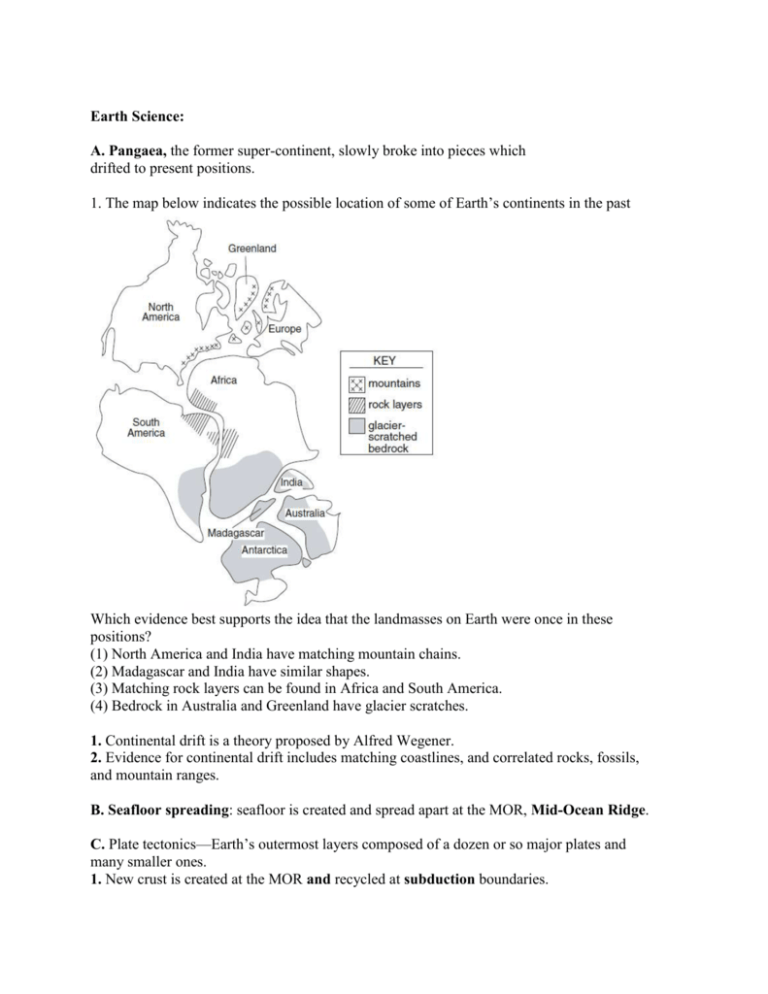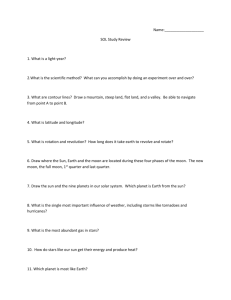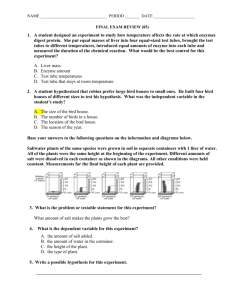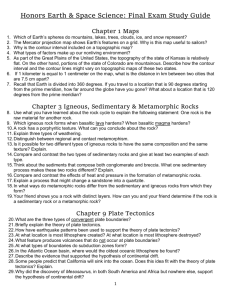Earth Science Review Packet
advertisement

Earth Science: A. Pangaea, the former super-continent, slowly broke into pieces which drifted to present positions. 1. The map below indicates the possible location of some of Earth’s continents in the past Which evidence best supports the idea that the landmasses on Earth were once in these positions? (1) North America and India have matching mountain chains. (2) Madagascar and India have similar shapes. (3) Matching rock layers can be found in Africa and South America. (4) Bedrock in Australia and Greenland have glacier scratches. 1. Continental drift is a theory proposed by Alfred Wegener. 2. Evidence for continental drift includes matching coastlines, and correlated rocks, fossils, and mountain ranges. B. Seafloor spreading: seafloor is created and spread apart at the MOR, Mid-Ocean Ridge. C. Plate tectonics—Earth’s outermost layers composed of a dozen or so major plates and many smaller ones. 1. New crust is created at the MOR and recycled at subduction boundaries. 2. When plates move a. apart from one another, divergent boundaries are formed. b. towards each other, convergent boundaries are formed. c. horizontally against each other, they form transform boundaries. 3. Thermal energy is the driving force behind all plate motion. The map below shows some geologic features located near the west coast of the United States. The arrows on either side of the fault represent (1) volcanic eruptions (2) rock formations (3) the relative movement of air masses (4) the relative movement of tectonic plates D. Convective flow—drives plates within mantle Causes—any seismic vibration of Earth caused by rapid release of energy D. Global earthquake distribution 1. Earthquakes occur at varying depths. 2. Earthquake zones are near the locations of plate boundaries. Earthquake Waves Earthquake waves travel out in all directions from a point where strain energy is released. This point is the focus, or point of origin, of an earthquake. The focus is usually deep inside Earth. The epicenter is the point on Earth’s surface directly above the focus. This is demonstrated in the figure below. A. Seismic waves provide information about Earth’s composition. 1. Scientists study earthquake-generated seismic waves to learn about Earth’s interior. B. Earth’s interior 1. Earth’s interior has a layered structure. 2. The layers become denser with depth. C. Layer composition 1. The crust and mantle are rocky, mainly consisting of silicates. 2. Earth’s cores are highly dense, with a metallic composition Base your answers to questions 1 and 2 on the diagram below, which shows a model of Earth’s interior. 1. What information did scientists study in order to develop this model? (1) recordings of earthquake waves (2) locations of recent volcanic activity (3) core samples from seafloor drillings (4) fossils found in rocks 2. Many scientists believe that crustal plate movement occurs because of convection cells contained in Earth’s (1) crust (2) mantle (3) outer core (4) inner core A. Magma 1. Magma originates as molten rock material below the surface. 2. It is forced to the surface by the higher density of surrounding rock and erupts at Earth’s surface as lava. D. There are three types of volcanoes. 1. Cinder cone volcanoes are small and erupt violently. 2. Composite volcanoes are large and erupt violently. 3. Shield volcanoes are very large and erupt with a quiet expulsion of free-flowing lava. Rocks: A. Only a few elements combine to form most of the common minerals in Earth’s crust. B. Mineral —a naturally occurring inorganic solid with a predictable chemical composition C. The way minerals break is determined by the arrangements of the atoms and the bonds between them. 1. Cleavage —breakage along planes that results in a smooth, flat surface 2. Fracture —irregular, uneven break D. Bonds connecting atoms in minerals often have different strengths. 1. Hardness —a minerals resistance to scratching E. Luster —the way a mineral reflects light 1. Metallic luster minerals reflect light in a way that a metal surface might. 2. Nonmetallic luster minerals shine like glass or appear earthy or waxy. F. Streak is the color of a mineral in powdered form. 2. Solidification from molten rock material a. Magma : molten rock material found inside Earth b. Igneous rock : is formed from lava that has cooled and hardened A. Sedimentary rocks—form from fragments of other rocks 3. Biochemical sedimentary rocks contain the remains of living organisms. a. The hard parts, or shells, of organisms are composed of calcium carbonate and are cemented together by calcite mud. b. Coal is a carbon rock formed by compressed plant material. 1. The diagram below shows a rock sample and an identification key. This rock sample would best be classified as (1) volcanic (3) metamorphic (2) sedimentary (4) igneous A. Metamorphic rocks have been changed by come combination of thermal energy, pressure, and chemical activity. Skill: Organizing Information Directions: Carefully study this diagram of the rock cycle. Then answer the questions. 1. What processes, combined with weathering, result in the formation of sediment? ______________________________________________________________________ ______________________________________________________________________ 2. What two processes cause sediment to form sedimentary rock? ______________________________________________________________________ ______________________________________________________________________ 3. Is it possible for sedimentary rock to form sediment? How? ______________________________________________________________________ ______________________________________________________________________ 4. What forces can transform igneous rock into metamorphic rock? ______________________________________________________________________ ______________________________________________________________________ 5. Write the letter of the definition next to the correct term. ____igneous A. rock produced by deposition ____sedimentary B. rock changed by heat and pressure ____metamorphic C. rock produced by magma Base your answers to questions 6 through 8 on the cross section below and on your knowledge of science. The cross section shows the heat flow and movement of some material within Earth, causing sections of Earth’s crust (plates) to move. 6. How does the temperature of Earth’s crust compare to the temperature of Earth’s interior? _________________________________________________________________________________ _____ 7. Name two geologic features or events that might result from the movement of crustal plates. (1)_______________________________________________________________________________ _________________________________________________________________________________ (2)_______________________________________________________________________________ _________________________________________________________________________________ 8. How does the thickness of Earth’s oceanic crust compare to the thickness of the continental crust? _________________________________________________________________________________ _________________________________________________________________________________ Base your answers to questions 9 through 11 on the map below and on your knowledge of science. The map shows earthquake activity in and around the United States. Earthquake activity is indicated by dots. 9 State one reason that there are more earthquakes in the western section of the area shown on the map. ___________________________________________________________________________ ___________________________________________________________________________ ___________________________________________________________________________ 10. According to the map, what is the latitude and longitude of the location at letter X? [Your answer must include a value, unit, and direction for each. Latitude: ________________________________ Longitude: ________________________________ 11. List two actions that residents of the west coast might include in an earthquake emergency preparedness plan. 1._________________________________________________________________________ ___________________________________________________________________________ ___________________________________________________________________________ 2._________________________________________________________________________ ___________________________________________________________________________ ___________________________________________________________________________ Earth, Moon and Sun System: A. Models of the solar system explain the motion of the Sun, the Moon, planets, and other objects. 1. Geocentric models show Earth in the center of the solar system. 2. Heliocentric models place the Sun in the center of the solar system. Earth in Space A. Earth’s shape is similar to a sphere. 1. This shape is a round, three-dimensional object. B. Gravity is the attractive force between two objects. 1. This force depends upon the size of the objects and the distance between them. C. Earth’s magnetic field protects us from harmful radiation from the Sun. 1. The location of Earth’s magnetic poles changes slowly because of movements of Earth’s crust and mantle. D. Earth orbits the Sun in an elliptical path. Time and Seasons A. Earth’s rotation and revolution measure time in days and years. 1. The prime meridian is an imaginary line drawn on Earth and used as a worldwide system for measuring time. 2. The apparent movement of the Sun is caused by Earth’s rotation. B. During the year, the Sun moves on a path known as the ecliptic. 1. The 12 constellations through which we see the Sun move during the year are called the zodiac. C. Earth’s seasonal changes are caused by: 1. its rotation 2. its revolution around the Sun 3. the tilt of its axis D. Equinoxes and solstices are related to the tilt of Earth’s axis. 1. The Sun reaches an equinox when it is directly above Earth’s equator. 2. Solstice is the point at which the Sun reaches its greatest distance north or south of the equator. 3. There are more hours of daylight during the summer solstice than on any other day. 4. There are fewer hours of daylight during the winter solstice than on any other day. Earth’s Moon A. Because the Moon is closer to Earth, its gravity affects tides more than that of the Sun. 1. It takes the Moon the same amount of time to rotate on its axis as it does to revolve once around Earth. 2. For this reason, the same side of the Moon always faces Earth. When the Moon and the Sun are lined up and pull together, high tides are much higher and low tides are much lower than normal. These periods are known as spring tides. When the Sun and Moon are at right angles to Earth, the high tide is relatively low and low tide is relatively high. This condition is called neap tide. These conditions are shown in the figure below. Moon phases are the changing appearances of the Moon as seen from Earth. 1. The moon seems to change its appearance eight times each month. 2. During waxing phases, the Moon looks larger each successive night. 3. During waning phases, it seems to grow smaller. D. Lunar eclipses occur when Earth’s shadow falls on the Moon. 1. Partial eclipses occur when only a portion of the Moon moves into Earth’s umbra. E. A total solar eclipse can occur as often as twice a year. 1. People in the region where the Moon’s penumbra strikes Earth can see this total eclipse. 1. The Moon’s surface is visible to an observer on Earth because the Moon (1) reflects sunlight (3) absorbs light from Earth (2) produces its own light (4) transmits sunlight 2. A full Moon is observed in Buffalo, New York, on June 1. Approximately when will the next full Moon be observed in Buffalo? (1) June 7 (3) July 1 (2) June 15 (4) July 7 3. The diagram below shows Earth at four locations in its orbit around the Sun. Which motion do the arrows in the diagram represent? (1) Earth’s rotation (3) Earth’s revolution (2) the Sun’s rotation (4) the Sun’s revolution 4. The diagram below shows Earth as viewed from space. 5. What motion of Earth is represented by the arrow in the diagram? ______________________________________________________ Base your answers to questions 6 through 8 on the information below and on your knowledge of science. The Moon orbits Earth in a regular and predictable motion. 6. Approximately how long does it take for one complete cycle of the Moon’s phases to occur? ______________________________________________________ 7. What is the major force that keeps the Moon in its orbit around Earth? ______________________________________________________ 8. Identify one observable event, other than the Moon’s phases, caused by the Moon orbiting Earth. __________________________________________________________ Base your answers to questions 9 and 10 on the diagram below and on your knowledge of science. The diagram shows the position of Earth in relation to the Sun on December 21, which is the first day of winter in the Northern Hemisphere. The shaded area represents the portion of Earth experiencing nighttime. 9. The diagram below shows Earth in relation to the Sun on June 21, which is the first day of summer in the Northern Hemisphere. Draw and label the positions of the North and South Poles on the diagram. 10. On the diagram below, shade the portion of Earth experiencing nighttime on June 21. Earth’s Atmosphere Seventy-eight percent of the atmosphere is nitrogen and 21% is oxygen. The remaining 1% includes mostly argon and trace gases. The atmosphere extends to 10,000 kilometers above Earth’s surface. 1. The first 30 kilometers of the atmosphere is called the troposphere. 2. The atmosphere above 30 kilometers is called the stratosphere.









